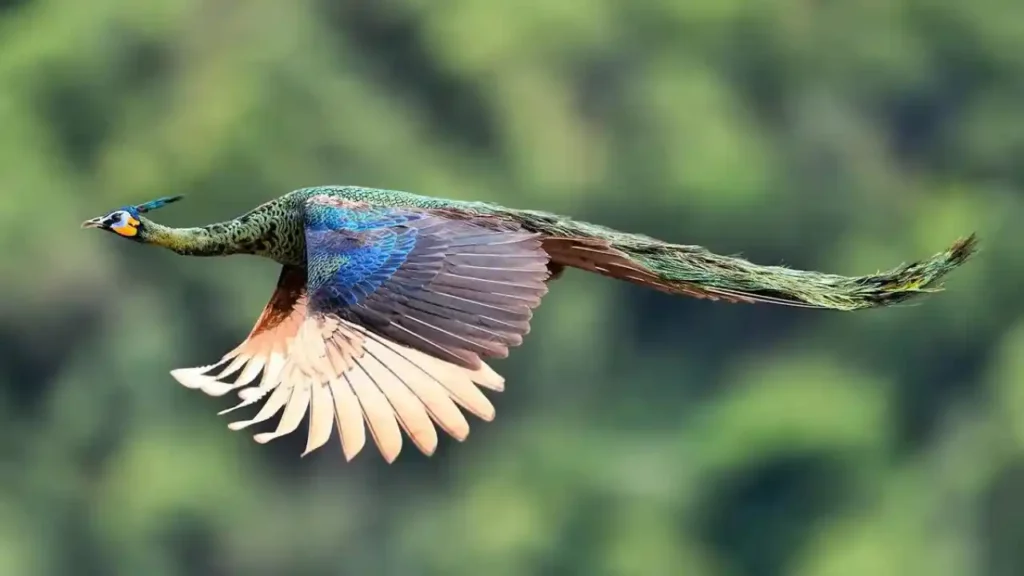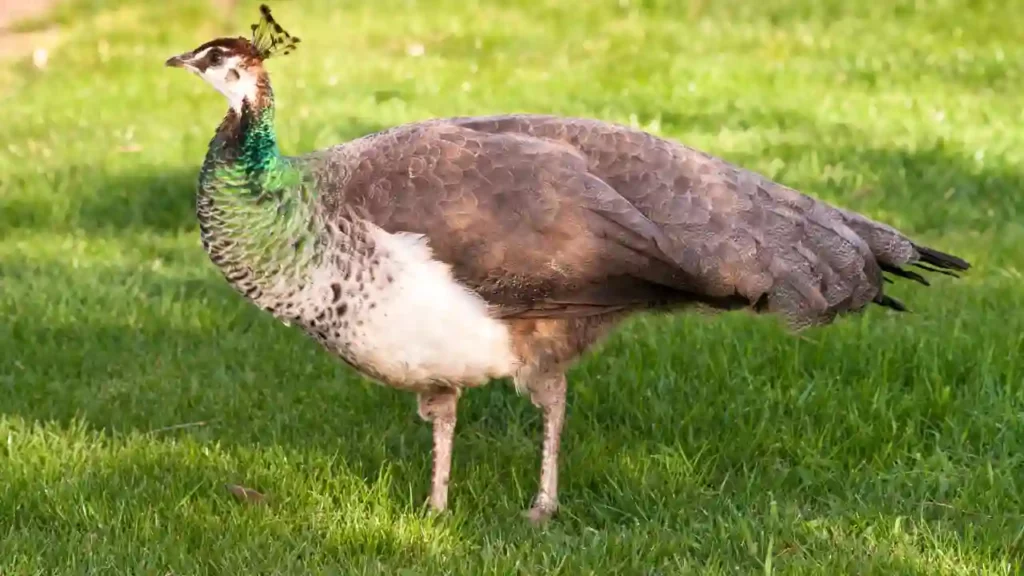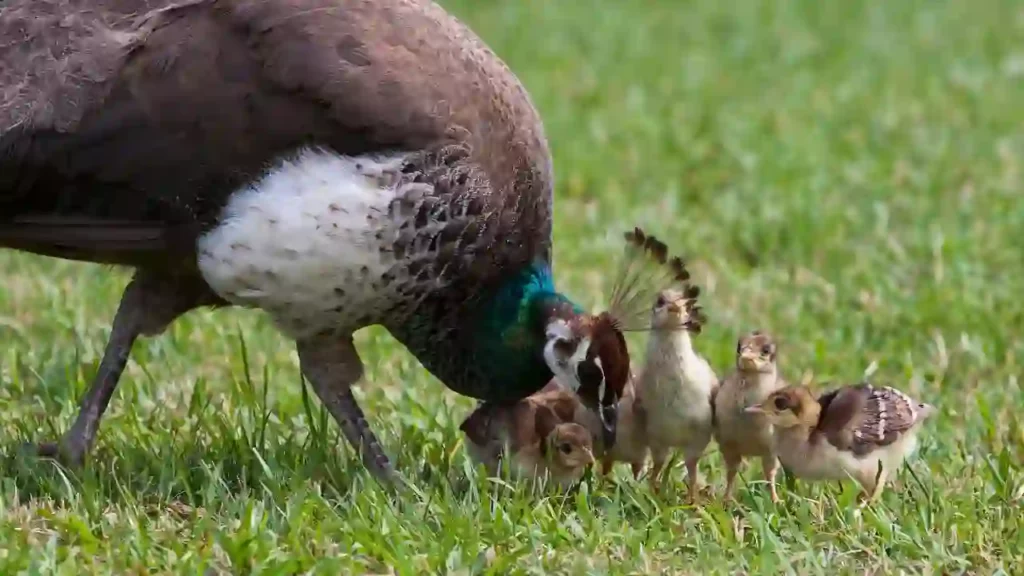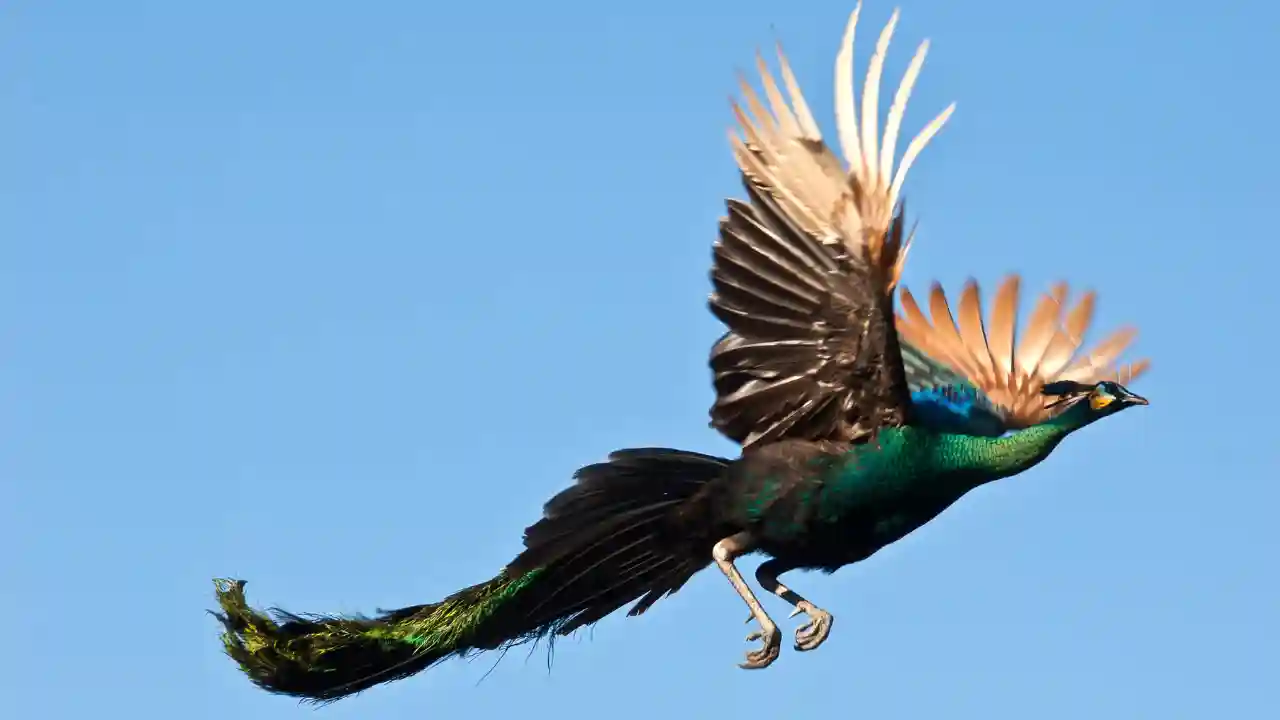Have you seen a flying peacock? Yes, they are beautiful birds but many individuals think of peacocks as akin to ostriches who can’t fly because of their bulky size, so are peacocks flightless bird or can they fly?
Despite their enormous size, peacocks can technically fly. They can only fly a short distance since they are unable to maintain their flight for an extended amount of time.
Peacocks are known to gallop and make multiple little jumps before making a large final hop. They can’t fly long distances, but they can flutter a great way because of their enormous long tail feathers.
We’ll discuss more how and when these peacocks learn to fly and what helps them in this action:
How Do Peacocks Fly?

Peacocks flap their feathers long enough to take flight. The flying procedure of peacocks is different from that of relatively shorter birds.
They begins to move by sprinting, then jumps, and ultimately sprang into the air to take flight. The peacock’s broad plumage is a vital factor and helps the bird as it is about to land by enabling it to glide to the ground till it rests on its feet.
Peacocks need to fly very rarely, they run mostly. They fly mostly when they sense danger or attack.
Unexpectedly, as most people tend to believe, the peacock’s lengthy tail feathers have no effect on the bird’s ability to fly.
Using their unusual technique to fly, Peacocks can fly for brief distances and up to 10 miles per hour in speed, despite their limited flight times.
How Far Can Peacocks Fly?

Peacocks can’t fly very far and that needs to be acknowledged. When they do go into the air, they typically only fly short distances, up to 8 feet in height and 100 m in distance.
They only fly this height and such distance because they can easily fall from this height and land in a tree or on a rooftop.
Peacocks typically don’t fly, but if they are startled or alarmed by something, they may do so.
However, even when they actually fly, they can only traverse around 300 yards in a single attempt.
That’s a tiny distance by any standard, yet it’s typically sufficient to free them from the situation they are ostensibly seeking to flee.
In theory, a peacock is capable of fleeing if you keep your peacocks in a backyard with a short fence.
Because there are so few circumstances in which it will truly wish to fly away, you shouldn’t bother about the thought that peacocks will flee your farm and even if they flee, pet peacocks are known to return home as they can’t fly great distances.
How Long A Peacock Can Fly?
Peacocks possess the ability to take flight, although their aerial journeys are relatively brief in duration and distance.
In fact, it is uncommon for large birds such a peacock to fly for more than a mile (1.6 km).
Generally, peacocks reserve their flights for situations involving a threat or imminent danger, when crossing obstacles like rivers, or when seeking refuge in trees for nocturnal roosting.
Furthermore, the peacocks flying can reach speeds of up to 40 mph (64 km/h) in the air. As they fly, their wings make a loud whistling sound that can be heard from quite some distance away.
While flight is not a primary mode of transport for peacocks, it is an important part of their natural survival.
How Fast Is A Peacock MPH?

Peacocks don’t have a fast flight. They occasionally go a little faster, up to a top speed of 10 mph (16 km/h).
They also run at a 10 mph pace. Peacocks must gain speed before they can soar through the air and achieve this by sprinting briefly before taking off into the air.
Other times, while attempting to climb a fence or other structure that is higher above the ground, the peacock just leaps into the air before briefly flapping its wings.
Peacocks dive down and sprint briefly after landing to slow down their velocity when they are currently on the rooftop of a building or in a tree and wish to return to the ground.
Peacocks’ ability to manoeuvre in the air is restricted. In fact, other than boarding and descending from trees or roofs, you won’t see them doing any complex flying manoeuvres.
How Much Height Can A Peacock Fly?
Peacocks fly in a manner that is comparable to high jumping. They can only fly a certain height and a certain distance due to their massive body size (up to 89 inches) and lengthy tail feathers.
The maximum height and distance that peacocks can fly are 82 feet high and 100 metres. This height is comparable to the lowest branch of a huge tall tree or a medium-sized tree at full maturity.
Peacocks don’t precisely fly with the same elegance and quickness that most birds do.
They begin by sprinting, then leap into the air to fly in order to gain velocity. Due to their large bodies and lengthy feathers, they cannot maintain their flight for an extended period of time. On the plus side, when they drop down from a high position, their thick plumage helps them touch down gently.
What Age Can Baby Peacocks Fly From?

Due to the rapid development of their wings and trail, baby peacocks start flying at a relatively young age.
As quickly as they get approximately 3 days old, new born peacocks can fly because of their rapidly evolved plumes.
However, just because they develop their plumes so early and have developed the ability to fly theoretically does not imply they will be allowed to leave the nest and fly by their parents.
They need a few months before they’re able to fly without running the danger of hurting themselves.
Baby peacocks can fly when they get to 6 months of age, exactly like any adult peacock.
Peacocks are well suited to living on the land, where they hunt and scavenge for food. Only if agitated or attempting to flee from something do they fly.
Since, it happens rarely that peacocks, need to fly, baby peacocks start regular flying after quite some time despite having a full-fledged train.
Can Both Male And Female Peacocks Fly?
Both male and female peacocks can fly, and they both do it using the identical method of lifting off their wings into air.
As the peahen is smaller and lighter than the male of the species, it has a greater advantage in flying.
Furthermore, females do not have the same lengthy train of elaborate feathers that males have.
The female’s train is only around 55 to 63 inches long and hence, less heavy contrasted to the male’s train, which measures from 70 to 98 inches.
Some scientists performed research examining if the long train feathers of peacocks interfere with their ability to fly. It was discovered that a peacock’s capacity to fly was unaffected by the lengthy train.
The study was conducted by removing certain peacocks’ tail feathers and evaluating how well they could fly in comparison to peacocks with undamaged tail feathers.
Interestingly, the train feathers had no effect because both peacocks had the same amount of difficulty flying. Therefore, other variables or a mixture of factors might be to blame for these birds’ poor flying abilities.
The results of the above-cited study proved to us that both male and female peacocks can equally fly. We might think, looking at the large feathers of the male that they are probably the lone flyers in the species, but it is not true.
Females, while not possessing the lengthy train, can fly equally well.
Why Don’t All Peacocks Fly?

As we already talked about, naturally, peacocks can fly, both male and female.
If you have witnessed peacocks on someone’s farm not being able to fly, that might be because peacock owners decide to clip the wings of their birds to prevent them from roaming around and creating a random nuisance.
Wings of domestic peacocks are frequently cut, making it impossible for them to escape.
But, for your knowledge, it is important to mention that even with their wings removed, peacocks can still jump up to 8 metres in the air. As a result, peacocks kept in captivity often jump over and breach out of their farm.
If you are deciding to keep some peacocks for yourself, you will require quite high fences to keep them contained if you wish to prevent them from fleeing.
Even if your peacocks flee, you shouldn’t stress too much because peacocks maintained in enclosures for a brief period of time quickly learn to return there for roosting and eating, so your peacocks will return even if they ran away.
But your neighbors may not like their roaming around since they are extremely noisy birds and can make life really difficult at night.
What Other Birds Are Like Them?
Peacocks are not the sole creatures with short wings and a hefty physique; there exist other avian species such as turkeys, guinea fowl, and ostriches that possess comparable flight capabilities.
While these birds may not soar to great heights or cover vast distances, they have developed alternative means to thrive in their respective environments.
| Birds with Similar Flight Abilities | Description |
| Turkeys | Turkeys, magnificent ground-dwelling birds, are indigenous to North America. With their short, rounded wings, they may not excel in sustained flight, but they possess the power to swiftly flap their wings to evade threats or gracefully glide short distances to find refuge in the embrace of trees. |
| Guinea Fowl | Guinea fowl, native to Africa, are avian creatures resembling peacocks. They possess compact wings and a robust physique, which limits their flying capabilities. These birds primarily dwell on the ground, diligently scouring for insects and seeds. |
| Ostriches | Ostriches, native to Africa, hold the title for being the largest birds on Earth. These flightless creatures have evolved to exchange the gift of flight for the ability to sprint at extraordinary speeds. Clocking in at up to 45 miles per hour, they proudly claim the throne as the fastest bipedal animals on our planet. |
| Emus | Emus, native to Australia, are flightless birds with small wings and a robust build, rendering them inept at flying. However, they compensate with their impressive running ability, reaching speeds of up to 30 miles per hour. |
| Kiwis | Kiwis are fascinating flightless birds that are indigenous to New Zealand. With their diminutive wings and elongated beaks, they skillfully scavenge for sustenance amidst the lush forest floor. Although incapable of flight, they showcase remarkable aquatic prowess as agile swimmers, effortlessly traversing rivers and streams. |
Final Thoughts
Such magnificent are these birds that they have so much mystery and myths around them and humans still don’t fully understand the characteristics of these very exceptional and exquisite birds.
But, contrary to common belief, peacocks’ train is not just for display but they are actually able to utilise their wings to fly through the air.
While their huge stature may take you to believe that they are flightless birds and related to ostriches, they are not, and are rather related to other ground birds, such as pheasants.
They may not be able to fly how most people imagine birds to be able to fly, but they can comfortably ascend into trees and descend to the earth from heights while evading natural predators and hunting for food.


